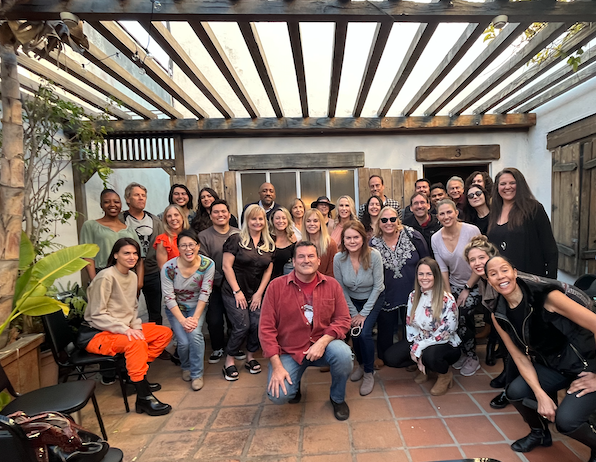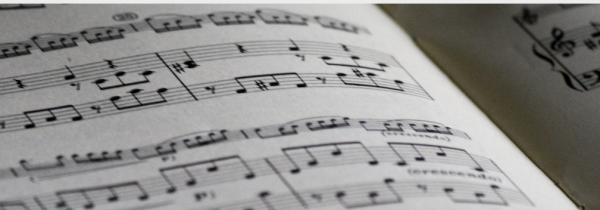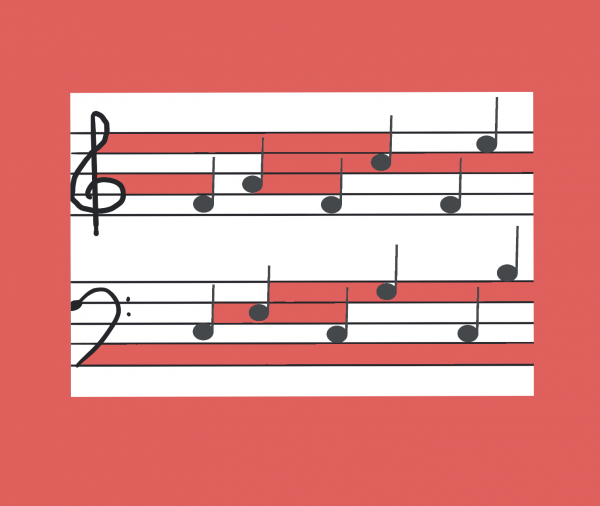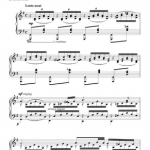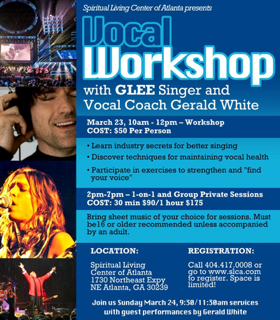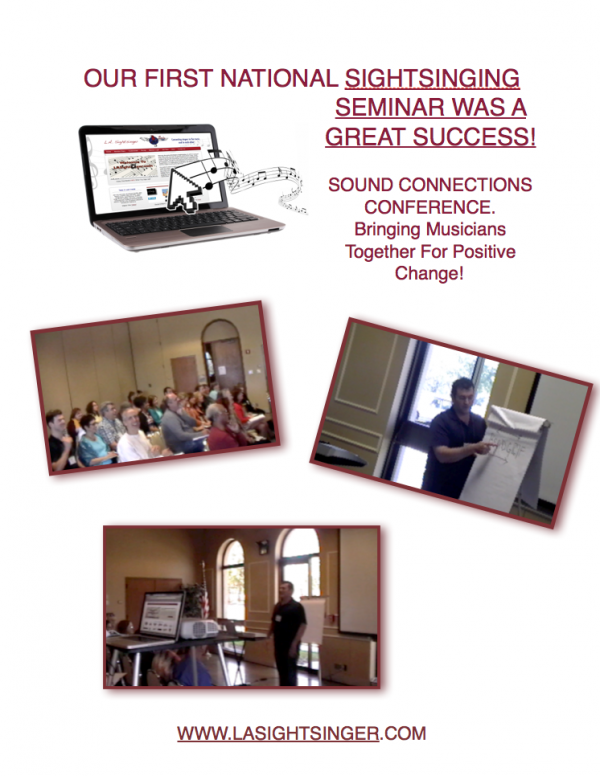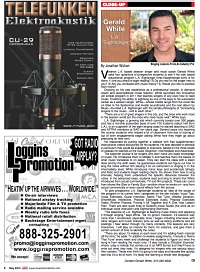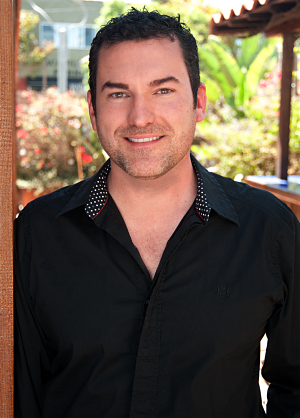Take Care Of Yourself!
Posted on February 10th, 2024The Magic Of 7
Posted on October 13th, 2023Music is built on the number 7. There are 7 sharp keys, 7 flat keys, 7 numbers, 7 letters, 7 common dynamics and so on…….It’s very mathematical however it’s not hard to understand the basic concepts if you remember some very simple steps while you approach sight-reading.
Here is one concept regarding key signatures which will help you.
Every letter in the sharp keys has an opposite letter on the flat side. The addition of these two numbers equals 7. For instance, if you notice how the key of F has 1 flat. The key of F# has 6 sharps. Added together that equals 7.
If you know that the key of A has 3 sharps, then what plus 3 equals 7? 4. So the opposite key of A which is Ab must have 4 flats.
E has 4 sharps, so Eb has 3 flats and so on.
That’s the magic of 7!
Inspired By A Fellow Singer
Posted on December 30th, 2022Mark Edward Smith was a recent guest at our last singer event. His story is absolutely amazing. It’s a true testament to how persistence and determination combined can take you to places unimagined as a singer and be able to make a great living doing what you love. Mark shared how he always takes the opportunities presented to him and says “yes.”
Also, he always continues to create new avenues of income through his different talents. Honing his skills with each new venture requires some serious discipline. I’m amazed at how many different instruments he plays, how many styles of singing he is able to show and how jumping into the acting world later in life has allowed him ample ways to succeed and prosper.
Many tend to slow down when they pass 50 and start heading toward retirement. Not Mark. If anything, he is even more determined to make new things happen and is at the top of his game. Mark has so inspired other singers to follow their dreams and not sit around and wait for opportunities to happen.
Have A Plan
Posted on September 8th, 2022The biggest mistake we make when starting to sightread is that we don’t have a plan. A method which gives us a step by step list is best.
For example, decide whether you are reading by interval (note to note), or by key and scale placement (where the notes land in the scale pattern. Also determine the key, whether it’s major or minor and find your starting pitch.
Look for trouble spots. Go through the piece and see if there are large interval jumps, key changes, repeat signs, etc….. Make notes and notations. This will give you more info as you read along.
Come up with your own checklist to use every time you have to sightread something. Then you have a plan and you are not just jumping in with no references.
Are You Giving Up Too Soon?
Posted on June 3rd, 2022Learning music theory or just music in general is like learning another language. As you’ve seen with languages, there are so many gimmicks promising to teach you to speak that language in 10 days, etc….
As you know, this just doesn’t happen. To speak a language takes time and most importantly, practice. You have to take the basics and apply those by speaking with someone who knows the language well. Until you apply it, it is sort of useless.
Add on top of that, learning this language as an adult which slows the process. As children, we pick it up with no trouble. As adults with busy schedules, we have to be extremely disciplined.
Music takes years to learn, not just a few months. Learning the basics of music theory is easy. But when you apply it and start to practice it, putting all of these elements together, you realize the difficulty of the task. I encourage you to not beat yourself up so much. Realize that this process is a long one. Take it step by step and practice in short time segments. Even five minutes consistently every day will bring results over time.
Don’t give up! Don’t fall for the short term promises. Make this a journey which will bring you such joy as music is our universal language.
Learning Your New Language
Posted on April 29th, 2022Learning to sightread is like learning a new language. It opens up a whole new world of possibilities for you as a singer and musician. As with any language, especially when learning as an adult, you have to be patient as it is a long process to become fluent. However, you will learn the basics quickly to start practicing. Remember that consistency is key. You don’t have to sit down for hours to do this. Take 10 minutes per day and review. On your own time, take the music you see for your choir, your band or just for your own pleasure singing at home and start to review what you are seeing on paper. Name it out loud. The key, the time signature, the note number. The concept is easy. The execution takes time.
The payoff is so rewarding!!
Interval Characteristics
Posted on April 7th, 2022Be Aware Of The Interval Characteristic
In jazz training, we were taught to hear chords as a unit with a certain characteristic.
Because in some cases, the player would use all 10 fingers with each finger on a different note, it seemed impossible to pick out each individual note quickly. So we learned to hear the unit and give it a name. Something about the sound of the chord reminded us of a color, or shape, or emotion, or style.
The same happens when you hear an interval. If a minor second is played, we tend to think “crunchy” or “dissonant.” Being able to link the interval with some adjective will help to quickly identify the interval and your ability to sightread will begin to improve.
Become a part of the learning with LASightsinger.com.
A New Years Resolution
Posted on December 21st, 2021Each year we start off with the best intentions.What I have found that works for me is to take very small steps. Make goals that you can do every day. Even if it’s only 5 to 10 minutes, doing something consistently works. It was one of those lessons learned in college from my professor that has stuck with me to this day. To be consistent is much more productive and brings much better results than to sit down and try to do something all at once.
With sight reading, it’s quite a long process. Especially if you’ve not had any musical training from the beginning. However, it is totally reachable and done the most successfully by spending a few minutes per day. This site, LAsightsinger.com gives you that option. Each of the video and audio portions are from 3 to 5 minutes long. You could do one a day and make great progress.
Remember it’s the small steps that count!!
Happy Holidays everyone! Here’s to an amazing new year!
10 Tips To Save Your Voice
Posted on July 13th, 2021Some 7 million Americans have some type of voice disorder, according to the American Academy of Otolaryngology.
Hogikyan and colleagues have put together the following 10 tips to help keep your voice in shape:
Written By: Norman Hogikyan and colleagues at the University of Michigan
1. Drink water to keep your body well hydrated, and avoid alcohol and caffeine. Your vocal cords vibrate very fast, and having a proper water balance helps keep them lubricated. Important note: Foods containing large amounts of water are excellent hydration-conscious snacks, including apples, pears, watermelon, peaches, melons, grapes, plums, bell peppers and applesauce.
2. Allow yourself several “vocal naps” every day, especially during periods of extended use. For instance, teachers should avoid speaking during the breaks between classes and find quiet ways to spend the lunch hour rather than talking in a noisy staff room with colleagues.
3. Don’t smoke, or if you already do, quit. Smoking raises the risk of throat cancer tremendously, and inhaling smoke (even secondhand smoke) can irritate the vocal cords.
4. Don’t abuse or misuse your voice. Avoid yelling or screaming, and try not to talk loudly in noisy areas. If your throat feels dry or tired, or your voice is getting hoarse, reduce your voice use. The hoarseness is a warning sign that your vocal cords are irritated.
5. Keep your throat and neck muscles relaxed even when singing high notes and low notes. Some singers tilt their heads up when singing high notes and down when singing low notes. “The high notes are on the ceiling and the low notes are on the floor,” Rosenberg says. “Over time, you’ll pay for that”—not just with strained vocal muscles but also by causing future limits on the vocal range.
6. Pay attention to how you speak every day. Even performers who have good singing habits can cause damage when they speak. Many skilled singers don’t continue their healthy habits when they speak; indeed, says Herseth, “many people—including singers—should have much more breath flow when they speak.”
7. Don’t clear your throat too often. When you clear your throat, it’s like slamming your vocal cords together. Doing it too much can injure them and make you hoarse. Try a sip of water or swallow to quench the urge to clear. If you feel like you have to clear your throat a lot, get checked by a doctor for such things as acid reflux disease, or allergy and sinus conditions.
8. When you’re sick, spare your voice. Don’t talk when you’re hoarse due to a cold or infection. Listen to what your voice is telling you.
9. When you have to speak publicly, to large groups or outdoors, think about using amplification to avoid straining your voice.
10. Humidify your home and work areas. Remember, moist is good for the voice.
Affiliate Program
Posted on May 20th, 2021| For you or for anyone you know who would like to make some passive income, don’t forget about our Affiliate Program on LASightsinger. When students or friends use your link to sign up, each month you will receive half (50%) of what your members contribute to the site. This is perfect for voice teachers or music teachers who would like a place to send their students. As you know, this website offers an array of information. From videos to audio containing a curriculum that covers theory, notes, rhythm, dictation, name that tune, song samples, the process of putting it all together and many more tools to utilize. Literally hundreds of pages of sightsinging information. We also have individual level programs to track your progress. |
We Made It Through 2020!
Posted on February 8th, 2021“We Made It Through 2020
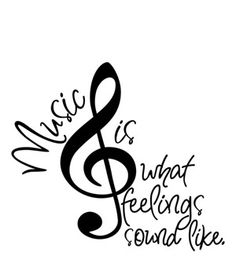 This past year has brought us some obstacles that have caused all of us to buckle up and be strong. In the midst of it all, many of you have found a way to make the most of your time at home and be creative or further your skills as a musician and singer. If you are reading this, then you’ve chosen to make use of this site.
This past year has brought us some obstacles that have caused all of us to buckle up and be strong. In the midst of it all, many of you have found a way to make the most of your time at home and be creative or further your skills as a musician and singer. If you are reading this, then you’ve chosen to make use of this site.
First let me say, thank you! I love teaching this material and am constantly trying new methods and tricks to make it as simple as possible. As you may notice, there are many changes being made to the site and this will continue over the next month. Because of my spare time during this past year, I’ve worked with the web developer to upgrade the system and also to create a lot of NEW CONTENT! These videos and upgrades are being implemented already and will continue. There are many new ones coming your way so stay tuned as we are finishing up the last few tweaks to the system upgrade before we add all of the new content.
I encourage each of you to reach out to me at any time. I’m literally an email away and we pride ourselves in the customer support we offer. That is number one for me with any business and I hope that if you have any questions or issues along the way, please do contact me. I will respond and help you in any way that I can.
Keep on SIGHTSINGING!!!!
More Tools In Your Toolbox
Posted on July 9th, 2020A recent student in class pointed out a different way of approaching key signatures. She was a little hesitant to say anything due to the fact that I was teaching it completely opposite from the way she learned. We discussed her method and learned some really neat new ways to think about it. I’m totally open to whatever works. And I find that the more tools you have in your box, the better. Some of us learned Solfege, some numbers but in the end, if you can sightread the music, then whatever works is awesome.
Be open to different routes to the same destination. Open your ears and try something new. You will then fill your box with amazing tools to assist this sometimes difficult process!
“Do” or “1”…..Which is best?
Posted on March 1st, 2019“Do or “1”
We all come from a background in music to some degree, especially if we are one of those people who grew up singing and is now either trying to make a career of it or just sing for fun.
With that background comes a method we learned, probably in elementary school. Depending on where you came from, you learned one of three methods of interval training:
1. Fixed “Do”
2. Movable “Do”
3 The Number “1”
I learned solfege and it seemed to work well for me. I’m writing this because this topic comes up pretty often when teaching my local class here. Some insist that their way is best and what I’ve found is whatever you learned early on is the easiest for you.
However, when I’m working with a student who has never learned anything regarding intervals, learning by numbers gets the fastest results in my experience. Also, as a working singer across the board, most directors/producers ask for a certain place in the scale, like the 5th for instance instead of asking for “So.”
Using numbers centers on scale placement, all depending on which scale the song is written from. Try singing a scale using the numbers 1-8. Then as a practice, incorporate different scale structures like harmonic minor, or melodic minor, keeping the numbers the same but changing the scale. It’s a process of thinking in a specific mode while you are singing to a place in that mode or scale.
Again, no one method is preferred by everyone. Choose which one works best for you and get the basics down. This will make sight-reading a much easier process for you.
Different Methods
Posted on June 1st, 2018Different Method
A recent student in class pointed out a different way of approaching key signatures. She was a little hesitant to say anything due to the fact that I was teaching it completely opposite from the way she learned. We discussed her method and learned some really neat new ways to think about it. I’m totally open to whatever works. And I find that the more tools you have in your box, the better. Some of us learned Solfege, some numbers but in the end, if you can sightread the music, then whatever works is awesome.
Be open to different routes to the same destination. Open your ears and try something new. You will then fill your box with amazing tools to assist this sometimes difficult process!
Ask Questions
Posted on February 2nd, 2018Ask Questions
I was standing next to a friend of mine the other day who is probably one of the best sight readers in town. I noticed how he hums a few notes before each entrance during a rehearsal. I figured since he was excellent at what he does, I would ask him a few questions.
During our break, I asked him why he hums before each take. He went on to explain how getting his cords ready, in position so to speak, makes the entrance much cleaner and allows him to focus more on performance when executing the piece. This way he is not searching for notes when trying to sing the next phrase.
I understand that this may seem like it would bring a lot of chaos if everyone did it but the humming is so minimal that mainly only he hears it.
This is only one occasion where I’ve tried to figure out what makes reading easy for others. Now, I always ask questions. Sometimes one little piece of advice will bring a huge revelation to your understanding and bump your sight reading up a notch.
New Goals
Posted on December 31st, 2017New Goals
Here we are again at the start of a new year….2018! Many of us make new years resolutions and try to reset for what’s in store. If learning to sightread is your goal, then as with anything else, it takes much discipline.
This past year I went on a journey of health. After years of trying to skate around reality, I finally decided that to be healthy, both in mind and body, I had to incorporate serious discipline and sacrifice into my daily schedule. No quick diets, or fancy home gym gadgets were going to do the trick. It was time to buckle down and get to work. It’s hasn’t been easy at all. In fact, I realized that I let many years pass by without sticking to a regimen and to have to reverse all of that is brutal……but definitely doable.
It takes time, going when you don’t want to go, working when you don’t want to work, eating right when you would love to have that pizza. But in the end, it has been life changing.
I heard a quote early in my life that said, “anything worth having in life, takes sacrifice.” Sacrifice is giving up one thing for the sake of a better cause. Good ole fashioned discipline is crucial.
So if you want to sightread, take the time. Make the sacrifice to gain this incredible skill. A little bit everyday goes a long way.
Happy New Year!!!
An “Ah Ha” Moment
Posted on October 3rd, 2017An “Ah Ha” Moment
Do you need an Ah Ha moment? It’s the most exciting thing to see as a teacher? When I see that “the light went on” and the student bursts out in the middle of someone else’s conversation or in the middle of class and says, “I got it” then it makes my day.
These are happening more often than not. Why, because people are starting to understand that sightreading is very simple. It just takes consistency and practice.
The great thing about being in a class is the interaction that takes place. Bouncing ideas back and forth and realizing there are many ways to the destination just accelerates the progress.
Be open to new ideas and find a class where you can join in and learn how to sightread.
Be Open To All Viewpoints
Posted on August 1st, 2017When a student comes to me and says that their way is the only way, I quickly know that the road to there destination is a very long one. Everyone comes from a different background and different training. We all have methods that have been taught to us and work for us well. We also should be aware that there are many methods which have been used over the years to accomplish the same task.
As mentioned before, I think of it as a toolbox. The more tools, the more prepared you will be to accomplish whatever it is you want.
In this case with sight reading, the more tools you have, the better off you will be. In every circumstance there are opportunities to utilize more than one method and create a situation of success.
Be open to all opinions and ways toward advancement. You’ll find that others may have a nice little trick that works for them and will work for you too.
What Sightsinging Does For Me
Posted on June 5th, 2017I recently was called for a live performance. There was no music ahead of time and only a few run-throughs before the show which was to take place in front of an audience of 10,000 people. It was a thrill and honor to be able to be called for this but more than anything, it made me realize how many more opportunities I gain by being able to read music quickly. The end result was to be able to sing with an amazing group of 24 singers and experience an exciting live performance.
There was no teaching of parts. Just a count off and “BAM” we were off and running.
Take A Snapshot
Posted on May 1st, 2017Take A Snapshot
My college professor used to make me take small snapshots of measures and then cover them up so that as I was playing the measure covered up, I was reading ahead to the next measure at the same time. This is great practice.
For example, you look at measure one and memorize quickly. Then cover it up with a piece of paper. While playing/singing measure one, you are making a mental note of measure two. Then cover up measure two and sing that measure while taking mental note of measure three. And so on………….
A sight readers, we are always looking ahead to see what the next bit of music is. This keeps us on our toes and prepared for what is coming next.
Be Open To Learning New Methods
Posted on February 28th, 2017A recent student in class pointed out a different way of approaching key signatures. She was a little hesitant to say anything due to the fact that I was teaching it completely opposite from the way she learned. We discussed her method and learned some really neat new ways to think about it. I’m totally open to whatever works. And I find that the more tools you have in your box, the better. Some of us learned Solfege, some numbers but in the end, if you can sightread the music, then whatever works is awesome.
Be open to different routes to the same destination. Open your ears and try something new. You will then fill your box with amazing tools to assist this sometimes difficult process!
Teaching The Godfather How To Sing
Posted on November 14th, 2016I wanted to share this article that was posted this week. Wes Moore has been instrumental in providing a video service for this site that works tremendously. Take a look and share!
Looking Ahead
Posted on April 30th, 2016Look Ahead For Possible “Crash & Burn” places. Take a few minutes before every piece and see what is ahead. It’s like some learn in Boy Scouts, “Always Be Prepared.” Look for possible key changes, tricky intervals, page turns with many notes during the turn, words which may be hard to pronounce or appear as tongue twisters. These are just a few but as long as you know what is coming up, it makes reading much easier. Often times you’ll have more than a few minutes to even practice some of the harder parts and be ready when you get to those parts to sing. – See more at: https://www.lasightsinger.com/member-welcome#sthash.TCr6aKJo.dpuf
What Are Your Habits?
Posted on February 29th, 2016Whatever your habits, these are the things that mold and make who you are as a singer. All the little things we do that we don’t pay attention to like……losing sleep over time, letting your posture start to fall forward, drinking too many cups of coffee…….or just turning on the t.v., when instead 5 minutes of looking over a piece of music would put you a few steps ahead.
I encourage you to just be aware of what steps you are taking daily to move forward in your music. Whether this is being a better sight reader or better singer, daily steps have to be taken to keep the ball rolling. Are you stepping forward or are you falling back?
Take notice of your habits. You may not even be aware that some of those habits are holding you back.
Say It Outloud
Posted on August 31st, 2015Every time you look at a piece of music, ask yourself the basic questions out loud. Then answer yourself out loud. There is nothing better than seeing, hearing, speaking and thinking something all at the same time. It becomes part of your memory much faster that way. This will also get you in the habit of a consistent review. So next time your choir has rehearsal for instance, before each new song, quietly to yourself, review the basics: key signature, time signature, starting note number, dynamics, etc……… –
Just Do It!!
Posted on July 1st, 2015Just Do It!
I remember several years ago where I was involved in a year long program, teaching me to be a “Champion.” It was quite an experience and I’ll never forget entering thinking I was going to figure out the “secret” to success. There were many books to read, audio tapes to listen to, conferences to attend and repeating positive affirmations to increase the results of my actions.
This year was the most productive year I ever experienced but not because of the books, the positive affirmations and all of what I thought was going to be my secret. What was it? It turned out to be the fact that this program forced me to be accountable, to show up and to get the job done whatever that was supposed to be.
I opened a new studio, gained an assistant and tripled my clientele. Why did this all happen?
Again, it was the fact that each week I had to be there. I had to do my homework and be accountable.
I had to “Just Do It.”
I equate it to working out. If you can just make it out the door, you’ve won the battle. Doesn’t really matter which program you use, just pick one and go with it.
I write all of this because the more successful this program becomes, I’m faced with many who ask why I do it the way I do. Why do you use numbers instead of solfege they ask. I answer them by saying, I chose a way and just started doing it. Why do the local classes work so well? Because we show up. We just do it. Any method we use would work. But the difference is we choose one and run with it.
When you are practicing your sight-reading, know that there is no best way. The right way is if you are consistently moving forward, whatever method you choose.
Pick some class to be a part of and “Just Do It.”
Ask Yourself The Hard Questions
Posted on January 1st, 2015Ask Yourself The Hard Questions
As we come into the new year, we always stop and evaluate where we are and where we are going. Even if we don’t plan to, our minds seem to go there. Did we get what we wanted this past year? Will I ever learn to Sightread or do anything else I put my mind to for that matter?
As you start off this new year, ask yourself a few questions and think about what it really takes. I wrote an article to my private students about being excellent at your craft. Being so good at what you do that they just can’t ignore you. And to accomplish this level of excellence, it takes good ole fashioned hard work.
- How bad do you really want to learn to sightread?
- How much time everyday do you spend practicing this craft?
- Do you put yourself in situations requiring you to sightread?
- Are you taking classes?
- Are you forcing yourself to learn the new piece one measure at a time or are you getting someone to play it for you?
- Are you falling for all of the gimmicks? Or do you realize that this comes by daily practice and hard work?
I always compare these situations to eating and health. Why? Because we all have to eat and we all have to maintain health. And we all know that none of it is accomplished overnight or with an app. It’s accomplished by very small daily steps which keep us on track and moving one little step forward at the time.
I encourage each and every one of you to keep going. Remember the small steps. I repeat this over and over and believe it wholeheartedly. You will get there IF you take the small steps consistently.
I wish you all a very successful 2015!!
Look For The Trouble Spots
Posted on November 30th, 2014Look For The Trouble Spots
After you have established the key and time signatures, the next step is to scan through the piece and see where the tricky places are. Often times, it’s one huge leap that throws us off or even an unusual accidental like a double sharp. If we know in advance, then we will be prepared and not get thrown off track at that place. Most singers I work with carry a pencil with them at all times and write in the music where these places are.
Another great symbol to use is a pair of glasses. It means to watch the director so you are not all of a sudden singing solo. The incredible thing about group singing which is where most sightsinging occurs is that there will be a synchronicity that happens. One person is strong when the other one is weak. If you’ve prepared your quick synopsis of the piece, then you can be that strong voice during the roadblocks and not get caught off guard.
Melodia, A Tried And True Method
Posted on November 1st, 2014Melodia– Written In 1909
Have you ever tried using the book Melodia It is tried and true, written by Cole and Lewis back in 1909.
This book has been around for years and I have say one of the best practice tools available. It covers every key, every time signature, every rhythm and every combination of intervals imaginable. If you get the complete collection, you will start from the very basics and travel through the really complex towards the end. If you can read Melodia you can read anything!!
Sometimes going back to the very basics is a step which can bring us back to reality. I have my classes read through it because regardless of what style of music you study, this foundation will cover it all.
You can now download this for free at https://openlibrary.org/books/OL24178198M/Melodia.
There are also versions for your iphone and ipad.
Say It Outloud
Posted on October 1st, 2014Say It Outloud
Every time you look at a piece of music, ask yourself the basic questions out loud. Then answer yourself out loud. There is nothing better than seeing, hearing, speaking and thinking something all at the same time. It becomes part of your memory much faster that way. This will also get you in the habit of a consistent review. So next time your choir has rehearsal for instance, before each new song, quietly to yourself, review the basics: key signature, time signature, starting note number, dynamics, etc………
It’s All In Your Mind
Posted on August 31st, 2014It’s All In Your Mind
We all play this vicious game in our heads. And who do we play it with?
Ourselves………..
We often start to beat ourselves up before we ever start to sightread.
As soon as it’s our turn to audition and the director gives us the music, we
go through every reason in the book of why we can’t do it. Our palms start to sweat and
singing, which is normally so easy, seems to be the most difficult task ever.
Before you start sight-reading that song, begin to tell yourself that this is something you can do. You’ve rehearsed, practiced and taken much time to go through the routine. Now start to let that little voice in your head know that
“You’ve Got This.”
Review the concepts so much that it becomes truly a habit of going through the steps every time you pick up the music.
Remember, You’ve Got This!
Is Perfect Pitch Necessary?
Posted on July 31st, 2014Is Perfect Pitch Necessary?
There is always a student in one of my classes who has perfect pitch. They seem to be envied by many…….but is it really necessary?
Let’s first address who has it and how you get it. It is a gift! You are born with it. Can anyone learn perfect pitch? That is to be debated and yes, there are programs out there which teach it. But it has been my experience that the ones who have it naturally are the ones who can utilize it and it is an added benefit to them.
I don’t teach perfect pitch, because if you actually walked down that road, it’s a longgggg walk. What you need is the ability to hold a given pitch in your head which we call “Do” or the tonic or key center. Then you learn to determine how far notes are from that given pitch both audibly and on paper. So if you are wondering if you are missing out, please don’t. It’s a very small percentage of people who have it. But, the rest of us have done quite well without it.
Characteristics Of The Intervals
Posted on July 1st, 2014Be Aware Of The Interval Characteristics.
In jazz training, we were taught to hear chords as a unit with a certain characteristic.
Because in some cases, the player would use all 10 fingers with each finger on a different note, it seemed impossible to pick out each individual note quickly. So we learned to hear the unit and give it a name. Something about the sound of the chord reminded us of a color, or shape, or emotion, or style.
The same happens when you hear an interval. If a minor second is played, we tend to think “crunchy” or “dissonant.” Being able to link the interval with some adjective will help to quickly identify the interval and your ability to sightread will being to improve.
When I See Music I ……………………….
Posted on May 31st, 2014What Is Your Feeling When You See A Piece Of Music?
1. Panic
2. Look for the lyrics
3. Zone out and listen to my fellow singer
4. Study it to see if I can recognize what I am seeing.
I hope you said #4. Since you are in the process of learning music and learning to sightread, start taking the time to recognize several key elements:
1. Locate the key signature
2. Locate the time signature
3. Find 1 or the key note on the staff.
4. See if you can find your first pitch without help.
It’s all about taking the baby steps, but to do that, you have to stop running from music when you see it.
Are You Giving Up Too Soon?
Posted on May 1st, 2014Are You Giving Up Too Soon?
Learning music theory or just music in general is like learning another language. As you’ve seen with languages, there are so many gimmicks promising to teach you to speak that language in 10 days, etc….
As you know, this just doesn’t happen. To speak a language takes time and most importantly, practice. You have to take the basics and apply those by speaking with someone who knows the language well. Until you apply it, it is sort of useless.
Add on top of that, learning this language as an adult which slows the process. As children, we pick it up with no trouble. As adults with busy schedules, we have to be extremely disciplined.
Music takes years to learn, not just a few months. Learning the basics of music theory is easy. But when you apply it and start to practice it, putting all of these elements together, you realize the difficulty of the task. I encourage you to not beat yourself up so much. Realize that this process is a long one. Take it step by step and practice in short time segments. Even five minutes consistently every day will bring results over time.
Don’t give up! Don’t fall for the short term promises. Make this a journey which will bring you such joy as music is our universal language.
Lines & Spaces
Posted on April 3rd, 2014Sightsinger Tip–Lines & Spaces
Those pesky intervals keep getting in the way right? Just as soon as I get in a groove of reading the melody ascending or descending through a nice scale pattern, the melody has to jump. And the further it jumps the harder it is to reach it. Then add on top of that jumping down instead of up and it gets even a little harder.
There is a little trick to guessing the intervals quickly. If you notice, when both notes are on either lines or spaces, the interval will be an odd numbered interval like a 3rd, 5th or 7th. If one note is on a line and the other is on a space, then the interval will be even numbered like 2nd, 4th or 6th. This gives a quick clue and narrows down the options.
For example, you see two notes, one on a line and one on a space, and they are really far apart. Since they are far apart, it’s probably a 7th.
Try browsing through a piece of music and quickly identifying if the intervals you are reading are the same(both on a line or space), or different(one on a line and one on a space.)
Having many tools in your tool box counts towards being one step closer to becoming a faster sight reader.
“Do” or “1”, which do you prefer?
Posted on March 1st, 2014Sightsinger Tip–“Do” or “1”, which do you prefer?
We all come from a background in music to some degree, especially if we are one of those people who grew up singing and is now either trying to make a career of it or just sing for fun.
With that background comes a method we learned, probably in elementary school. Depending on where you came from, you learned one of three methods of interval training:
1. Fixed “Do”
2. Movable “Do”
3 The Number “1”
I learned solfege and it seemed to work well for me. I’m writing this because this topic comes up pretty often when teaching my local class here. Some insist that their way is best and what I’ve found is whatever you learned early on is the easiest for you.
However, when I’m working with a student who has never learned anything regarding intervals, learning by numbers gets the fastest results in my experience. Also, as a working singer across the board, most directors/producers ask for a certain place in the scale, like the 5th for instance instead of asking for “So.”
Using numbers centers on scale placement, all depending on which scale the song is written from. Try singing a scale using the numbers 1-8. Then as a practice, incorporate different scale structures like harmonic minor, or melodic minor, keeping the numbers the same but changing the scale. It’s a process of thinking in a specific mode while you are singing to a place in that mode or scale.
Again, no one method is preferred by everyone. Choose which one works best for you and get the basics down. This will make sight-reading a much easier process for you.
Intervals
Posted on February 1st, 2014Do You Know Your Intervals?
Do you remember those first piano lessons you had, or those really exciting theory classes at college? One of the first things we learn is intervals, the distances between two different notes. Intervals are what create the melodies of songs we hear every day. And these intervals have a certain “feel” so to speak.
A perfect 5th or a Tritone are two examples of intervals. These distances also give a very specific sound which can be both memorized and sensed through muscle memory. Unfortunately, the only way to tackle them is to take some time and listen to them over and over. I teach these intervals in class every day. We learn them with a fun exercise called “Singing The Alternating Scale While Leaving Out Numbers.” You can also practice this in the PRACTICE AUDIO section in the left column.
If you haven’t learned these intervals, you are missing out on one of the very basic elements of music theory and sight reading. Please take the time to do so and you’ll see your progress enhanced greatly. Besides this site, you can also download apps which are great for learning intervals as well.
Learn To Judge Distance
Posted on January 1st, 2014Even Vs Odd
When we look at intervals, we see on a music staff that all notes have a line through the middle or not.
When both notes of an interval have a line through or both do not, then the interval is an ODD interval.
When one note has a line through the middle of it and the other does not, then the interval is EVEN.
This is another tool to quickly asses distance between notes.
It may mean the difference in determining a 6th or 7th interval and actually getting it right.
Try to first look from note to note and recognize whether the interval spaces are ODD or EVEN.
Sight Reading For Fun!
Posted on December 1st, 2013Do You Sight Read For Fun?!!!
There is nothing like looking at a piece of music and understanding what is going on. It’s like a code that opens up a whole world of musical adventure within a few pages. We can go through the exercises regularly, learn our key signatures and practice theory all day but until we open the music and just start reading, we’ll never experience the thrill of the adventure.
Here in Los Angeles, there are several groups of singers who get together at someone’s house or church and everybody brings music with copies for all to share. They just dive right in, making mistakes in a safe environment and gaining the experience of seeing what it is really like not to rehearse but to try and read at first sight.
This is lots of fun, especially when the chords start to tune up and you realize you are producing music quickly that you’ve never seen before. Give it a try. Invite a few friends over and make it a fun experience.
A Letter From Allison
Posted on November 1st, 2013A Letter From A Student I Would Like To Share
I received an email from a former sightsinging student. It really makes what I do worthwhile to hear this. I would like to share it with you.
“Hi Gerald! I’ve been meaning to write you for the past few weeks- to thank you for the sight reading training I’ve received from you thus far. It turned out to be extremely beneficial during my High Holy Day choir job at Sinai Temple this past September. Our eight person choir was given seven FAT binders of music, and had basically three weeks to learn- and perform- all of it. Needless to say, the ability to sight read was paramount. And I noticed that, when I tried to fall back on my old habits (e.g. expecting to just “hear” my part/learn it by ear), I usually didn’t stand a chance. There was simply too much material in-hand to make that work. But when I applied simple techniques- e.g. determining the key, the interval, and/or what relation to the tonic my next note had, I was saved! I’m now amidst learning 108 complicated Christmas Carol arrangements, and once again- applying sight reading technique is key. I’m definitely far from perfect- and would most certainly still buckle if someone gave me a score to read cold- on the spot :-). But I’m certainly getting better. So thank you!”
Smartmusic Interactive
Posted on August 1st, 2013The new school year just started with Smartmusic. Take advantage of the weekly lessons I send you where you sing into the computer and the system lets you know if you are correct or incorrect by color responsive software. It’s an incredible way to learn. Login to Smartmusic.com and look for my class “Music one on one” for all levels.
How Do You Get A Swimmer’s Body?
Posted on June 29th, 2013Sightsinger Tip–How Do I Get A Swimmer’s Body?
The answer is obvious right?
My friend used to kid me all the time about a meeting I had with a trainer a few years ago. I asked him how could I get a swimmer’s body? The trainer said the obvious….SWIM!!! I came home and told my roommate at the time and he has been laughing at me ever since. He said, “what did you expect your trainer to say?”
I guess like everything else, we expect a secret formula. Sometimes there is nothing better than just jumping in the water and start swimming. Sightreading is nothing different. Sometimes there is no better training that to just pick up a piece of music and start reading it. Get a few of your friends and read through the hymnal from your church, or some music from your local choir.
It’s fun to do and somehow the muscles which need to be developed start getting stronger without you even knowing it.
So how do you get a good sightreader’s technique? Start sightreading!!
Some Will Always Say You’re Wrong
Posted on June 6th, 2013A great article by Derek Sivers.
Don’t Be Fooled
Posted on March 31st, 2013Don’t be fooled by teachers promising the world!! I believe in encouragement but I also believe in honesty with all of my students.
When teachers tell you that you can sing like “Nickelback” or have as much sound as “Jennifer Hudson”, run the other direction.
Some singers are born with massive instruments and cords of steel. We try to mimic them and end up with a multitude of problems. Don’t fall for promises you know deep down are not true. Learn to appreciate the voice you have and develop that voice to it’s full potential.
Sightsinging Conference-Atlanta Georgia
Posted on March 24th, 2013Is It Really Who You Know?
Posted on February 17th, 2013A great article about the business.
Focus, Entertain or Both?
Posted on February 1st, 2013You Don’t Have To Be Local
Posted on December 6th, 2012Here is a great article written by Derek Sivers. Take a minute and read.
YOU DON’T HAVE TO BE LOCAL!
Become A Respected Singer
Posted on November 30th, 2012Sightsinger Tip–Become A More Respected Singer To Your Band Or Music Group!!!
Have you ever heard a musician say, “Oh here is another dumb singer”?
The reason is because often times singers have no knowledge of music and strut their “Divaness” as if they are the Queen or King of all singers. Bands members for example are turned off by this because the singer has made no effort to understand the music other than what they are specifically singing. I can’t tell you how much respect you will gain by be able to identify certain simple aspects such as what key your song is in and what key would you put this in if you needed it a little lower or higher. Also, can you count off your song in the correct time signature? Knowing these simple things will provide you with a great experience of working with other musicians when it’s time for a band rehearsal or audition. Take the time to learn, even if it’s just to have a basic understanding of how music works.
Some New Tips
Posted on November 25th, 2012Want To Make It In Music?
Posted on November 1st, 2012Want To Make It In Music? Read This Incredible Article.
First National Sightsinging Seminar A Great Success!!
Posted on September 21st, 2012First National Sightsinging Conference
Posted on September 17th, 2012OFF TO KANSAS CITY MISSOURI FOR OUR FIRST
NATIONAL SIGHTSINGING CONFERENCE!!
VERY EXCITING!!
WWW.LASIGHTSINGER.COM
LA Local Job Opportunity
Posted on September 14th, 2012SATB Voices for Choir
Date: Sat, 10/06/2012
Time: 3 pm – 6 pm (rehearsal 3 to 4 – event starts at 4 pm)
Venue: St Michael & All Angels, 3646 Coldwater Canyon Ave Studio City, CA 91604
Rate: $50, plus light refreshments
Email resume and MP3 to: [email protected]
Questions: Call Richard Winter-Stanbridge at Office Tel: (323) 549-5470
More information details available at: www.Laurislist.net
Sight Reading Class For Singers-Los Angeles
Posted on September 10th, 2012SAG-AFTRA Sightsinging Classes For The Fall Quarter:
Classes start the week of October 9th, 2012.
Sign up Deadline is September 25th, 2012.
Sign up at www.lasightsinger.com/la-local.
Or call 310-430-4802.
Thanks!
Gerald White
[email protected]
Are You Trying To Do Too Many Things At Once?
Posted on September 4th, 2012Take The First Step
Posted on August 20th, 2012Take The First Step
We often wait until everything is right before we jump in to start anything. Well I have a doctor’s appointment the 2nd week of class so I’ll wait until the next time. Or, I didn’t finish my college sightreading course so maybe I should wait until I brush up before I join the class. Or, it’s way too expensive, when honestly it may be what you spend on Starbucks coffees in a week.
There are many excuses we use to put things off. Make the first step. Just start. Sign up. Enroll. Or simply just pick up a piece of music and see if you can figure out the first note.
Take the first step. Once in motion, the other steps will be easier!
Keeping Music Muscles In Shape
Posted on July 13th, 2012A great article by Amy Engelhardt originally posted on Lauri’s List.
Keeping Music Muscles In Shape
A Word Of Encouragement
Posted on June 25th, 2012A Little Goes A Long Way
I’m so excited about all of you who are logging in and moving forward. However, I know how frustrating it can sometimes be. Here is a word of encouragement. Take a listen.
Ideas vs Execution
Posted on June 17th, 2012“THE VOICE”-Auditions
Posted on June 11th, 2012To Sign up, go to www.NBCTheVoice.com.
Version 0.1
Posted on June 6th, 2012Singing Show Looking For Singers-Winner Earns Money!
Posted on June 6th, 2012From the producers of the hit shows, “Don’t Forget The Lyrics” & “Secret Millionaire,” we bring you…
“Sing If You Can”
“Sing If You Can” takes people out of their comfort zone to perform in extreme & hilarious circumstances. Every episode contestants will try to belt out modern hits and classic crowd-pleasers while taking on “extraordinary” challenges designed to distract them.
Do you have what it takes?
Please send us the following…
Name:
Age:
Phone number:
Picture:
And a quick note on why you’d be great for our show:
MUST BE 18 YEARS OF AGE AND MUST LIVE WITH-IN 4 HOURS OF LOS ANGELES.
Reply to [email protected]
Melodia-Free by PDF download and available on Kindle!!
Posted on June 1st, 2012MELODIA has been around for years and is the “go to” book for all sight reading teachers and schools. It has every imaginable key, rhythm, time signature and arrangement that you would ever see. Now it is available for free by pdf download. AND…….it is available for mobile devices and is readable on the KINDLE. To access the different formats, go to http://openlibrary.org/books/OL24178198M/Melodia
If It’s Not A Hit, Switch!
Posted on May 28th, 2012Revolution
Posted on May 14th, 2012Nobody Knows The Future-Derek Sivers
Posted on May 7th, 2012Music Connection Feature
Posted on April 30th, 2012Music Connection has featured LASightsinger in the May issue starting May 1st. Jonathan Widran takes a look inside to see what this new site is all about. Take a look for yourself at www.musicconnection.com.
Enjoy!!
Disney Auditions Around The World-4-12
Posted on April 28th, 2012Disney is holding auditions around the world for the different parks.
Information is below for anyone interested in auditioning.
Thanks For Your Patience!
Posted on April 25th, 2012We made our transition to the new server and to our new site.
Now that we are settled in with the new format, we will be adding more video and audio.
Our next week assignments are back on schedule such as Name That Tune and Dictation.
Smartmusic is up and running again as well.
If you have questions, please don’t hesitate to let me know.
Have a great week!
Welcome To Our New Site
Posted on April 22nd, 2012Dear LASightsinger Member:
We are switching to our new server by Monday evening, so it will happen within the next 48 hours.
Next time you go to the site, there are a few things you need to do and see.
1. Login with your user name which is the same email you have always used to login. The login button will be at the upper right hand corner of the screen.
2. Use the default password “lasightsinger”.
3. Once you have logged in, click on “account” at the bottom of the page and there you will be able to change your password to your choosing.
4. All membership emails are sent via CONSTANT CONTACT from [email protected]. Please check your spam box and make sure you allow messages to enter your mailbox so you will receive member notification and newsletters. You’ll notice I’m sending via both my personal email and constant contact this time just to make sure you receive the information.
5. As far as your membership accessibility, everything will remain the same.
Next, you will see some changes. After speaking with members and analyzing which features were used and which ones were not, we have chosen to focus our attention on the educational direction of the site and not the social networking side of it. For instance the forums and user profiles were never utilized.
For this reason, we will no longer have “user profiles” and “forums.”
However we have incorporated a BLOG page which will be updated frequently which will give latest information regarding singers, relevant singer topics, jobs/auditions, etc…….
The affiliate structure will be more of an exchange scenario. In other words, if you are a business (music studio, store, voice studio, etc…..) we can trade links.
To put it simply, we will place your link on the Links and Apps page and you will place our link on your webpage. For those of you who are currently affiliates, please change the link I sent you back to the simple link…lasightsinger.com.
The site is now much simpler yet current. More technologically friendly and visually more easily navigated.
Please forgive us as we will not be adding this week’s Name That Tune and Dictation Assignments due to the changeover. We will be back on schedule the following Monday.
I appreciate your patience as we make this transition!!! As you know with any change in technology, there may be some glitches within the first few week of changeover.
Please let us know if you find something not working or if you have trouble accessing the information.
Know that the developers and I are here to troubleshoot any situation that needs repair.
Thanks again for your patronage!! I never realized the need for such a tool as this. The site is going great and I appreciate your contribution and participation!!
Gerald


